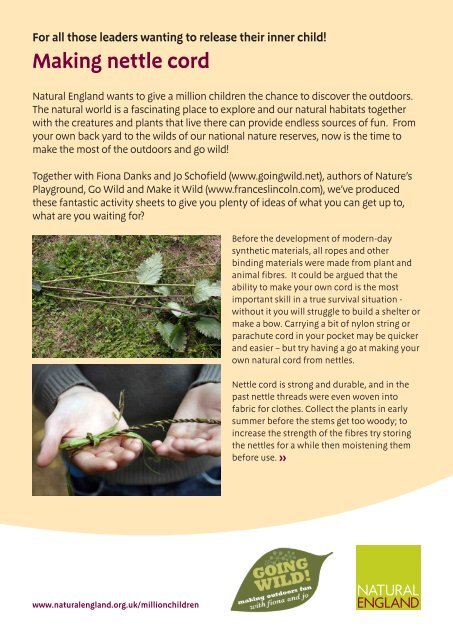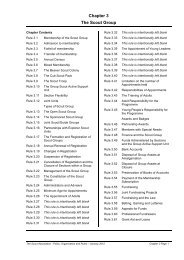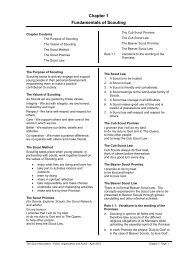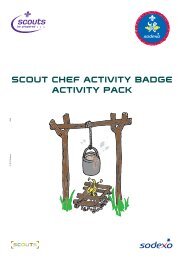Making nettle cord
Making nettle cord
Making nettle cord
- No tags were found...
You also want an ePaper? Increase the reach of your titles
YUMPU automatically turns print PDFs into web optimized ePapers that Google loves.
For all those leaders wanting to release their inner child!<strong>Making</strong> <strong>nettle</strong> <strong>cord</strong>Natural England wants to give a million children the chance to discover the outdoors.The natural world is a fascinating place to explore and our natural habitats togetherwith the creatures and plants that live there can provide endless sources of fun. Fromyour own back yard to the wilds of our national nature reserves, now is the time tomake the most of the outdoors and go wild!Together with Fiona Danks and Jo Schofield (www.goingwild.net), authors of Nature’sPlayground, Go Wild and Make it Wild (www.franceslincoln.com), we’ve producedthese fantastic activity sheets to give you plenty of ideas of what you can get up to,what are you waiting for?Before the development of modern-daysynthetic materials, all ropes and otherbinding materials were made from plant andanimal fibres. It could be argued that theability to make your own <strong>cord</strong> is the mostimportant skill in a true survival situation -without it you will struggle to build a shelter ormake a bow. Carrying a bit of nylon string orparachute <strong>cord</strong> in your pocket may be quickerand easier – but try having a go at making yourown natural <strong>cord</strong> from <strong>nettle</strong>s.Nettle <strong>cord</strong> is strong and durable, and in thepast <strong>nettle</strong> threads were even woven intofabric for clothes. Collect the plants in earlysummer before the stems get too woody; toincrease the strength of the fibres try storingthe <strong>nettle</strong>s for a while then moistening thembefore use. ››www.naturalengland.org.uk/millionchildren
<strong>Making</strong> the <strong>cord</strong>Remove all the leaves, wearing gloves toavoid being stung.Use a fingernail or a knife to split the stemlengthways and open it out.Tamp the opened stem down to make itflatter and softer.Remove the woody pith from inside thestem, leaving the floppy external fibres.To make this easier, bend the stem overyour finger to break the pith into smallersections. If you don’t want to waste the pith,dry it to make tinder for making a fire.Fold the length of fibres in two to make a Vshape.Place the two lengths across your kneenear the top of your leg, and hold on to thefolded end with one hand.With the other hand roll the two lengths offibre away from you, so that both lengthstwist simultaneously. When you have rolledthem as far as you can, let go of the end – itshould twist on its own.Repeat the process until you almost reachthe end of the fibres and then knot the endto secure.Instead of twisting the prepared fibrestogether to make <strong>cord</strong>, an alternativemethod is to plait them.Keep your <strong>cord</strong> in your pocket – you neverknow when it might come in handy!© Jo Schofield & Fiona DanksSafety tipsWear gloves to pick the <strong>nettle</strong>s and toremove the leavesDisclaimer: Please note, anyone taking part in these activitiesdo so entirely at their own risk. Natural England together withthe authors and publishers of these activities do not acceptany legal responsibility for any harm, injury, damage, loss orprosecution resulting from the activities described.
















